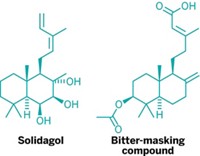Advertisement
Grab your lab coat. Let's get started
Welcome!
Welcome!
Create an account below to get 6 C&EN articles per month, receive newsletters and more - all free.
It seems this is your first time logging in online. Please enter the following information to continue.
As an ACS member you automatically get access to this site. All we need is few more details to create your reading experience.
Not you? Sign in with a different account.
Not you? Sign in with a different account.
ERROR 1
ERROR 1
ERROR 2
ERROR 2
ERROR 2
ERROR 2
ERROR 2
Password and Confirm password must match.
If you have an ACS member number, please enter it here so we can link this account to your membership. (optional)
ERROR 2
ACS values your privacy. By submitting your information, you are gaining access to C&EN and subscribing to our weekly newsletter. We use the information you provide to make your reading experience better, and we will never sell your data to third party members.
Biological Chemistry
Red Wine Mimics Defended
ACS Meeting News: Sirtris says controversial antiaging compounds act at an allosteric site
by Carmen Drahl
August 24, 2010
| A version of this story appeared in
Volume 88, Issue 35

Drug candidates meant to emulate the antiaging effects of the red wine component resveratrol work by binding to their enzyme target at a site outside the active site, according to research presented on Aug. 22 at the American Chemical Society national meeting in Boston. The discovery adds a new twist to a debate over whether the molecules, from GlaxoSmithKline subsidiary Sirtris Pharmaceuticals, work as claimed.
Resveratrol extends life span in fruit flies and worms, and it's been suggested that the compound works by acting on enzymes called sirtuins that remove acetyl groups from proteins. Sirtris was founded with the goal of activating the sirtuin pathway, thought to have a hand in the antiaging benefits of calorie restriction, to treat diseases of aging. The company developed a series of potential drug candidates, such as SRT1720, which it said were more potent sirtuin activators than resveratrol is. In 2008, GSK acquired Sirtris for $720 million.
But as early as 2005, scientists were debating whether resveratrol was a bona fide activator of SIRT1, the most widely studied human sirtuin enzyme. By 2009, three independent teams concluded that Sirtris' method for measuring SIRT1 activation was flawed because resveratrol activated SIRT1 only in the presence of a fluorescent peptide substrate used to measure its acetyl-removing activity. In January, researchers at Pfizer further fueled controversy by reporting that Sirtris' SIRT1-targeted compounds don't actually activate SIRT1.
At the meeting, Ross L. Stein, vice president of discovery research at Sirtris, fired back at critics. He said Sirtris' compounds do activate SIRT1. He said his team's data, recently published in the Journal of Biological Chemistry (DOI: 10.1074/jbc.M110.133892), suggest that the molecules act by binding to an allosteric site on the enzyme.
The Pfizer team had reported that SRT1720 and two other Sirtris compounds were binding to the fluorescent substrate, giving the illusion of SIRT1 activation. In Boston, Stein confirmed that those compounds do bind to the substrate. But he said this does not rule out an allosteric activation mechanism. He went on to describe other compounds that don't bind to the fluorescent substrate yet still activate SIRT1.
Matt R. Kaeberlein of the University of Washington, who questioned Sirtris' assay in 2005 but did not attend the presentation, says that although an allosteric mechanism is a good fit for the data in Sirtris' publication, the antiaging relevance of the company's compounds will ultimately be determined not by biochemical experiments but by animal models and clinical trials. "I don't think this study really means much for the field of aging-related science as a whole," he said.
The presentation came just more than a week after GSK asked two employees, both former Sirtris executives, to cease their association with a nonprofit group that sells resveratrol supplements online.





Join the conversation
Contact the reporter
Submit a Letter to the Editor for publication
Engage with us on Twitter